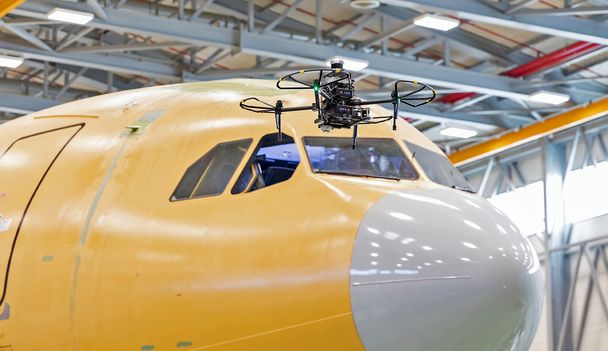Airbus innovation for military aircraft inspection and maintenance

A joint project is expected to significantly modernise the maintenance, repair and overhaul process of military aircraft
New technologies – including the use of drones, augmented reality and artificial intelligence – are coming together in an innovative Airbus system that offers the promise to revolutionise aircraft maintenance.
Called Drone and Augmented Reality inspections, the technology provides maintenance, repair and overhaul (MRO) operators with an end-to-end digital solution that facilitates the performance of tasks, while guaranteeing quality and adherence to airworthiness standards.
The Drone and Augmented Reality inspections services are being jointly developed by Airbus with a military service for inspections of Airbus-built A400M heavy-lift airlifters. Its application could be further extended to cover three other Airbus military airlifters: the medium-lift CN235 and C295 transports; along with A330 MRTTs (Multi Role Tanker Transports).
Reducing inspection time and creating a more robust maintenance, repair and overhaul process
Using drones equipped with high-definition cameras and a 3D augmented reality LIDAR (light imaging, detection and ranging sensor), the technology provides accurate positioning during the fly-around inspection, along with artificial intelligence for the detection of potential defects on the inspected aircraft – backed by the use of various devices such as smart glasses, tablets and team computers.
The use of Drone and Augmented Reality inspections will significantly reduce inspection time, while also lowering the risk of inadvertent damage caused by traditional inspection methods that require a build-up of scaffolding and the deployment of mobile equipment around the aircraft. As an example, a drone-based external inspection of a large aircraft such as the A400M (with an overall length of length of 45 metres) would take only two hours – while the same process requires weeks with traditional methods.
Applying artificial intelligence, and augmented/virtual reality
This technology also will play an important role in the next step: processing the drone-captured information and determining potential actions based on identified defects, discrepancies and damage that are discovered on the aircraft. Images and data are contextualised through a virtual aircraft model that uses mathematical logarithms (validated by quality inspectors). Artificial intelligence – more specifically, deep learning – increases the logarithms’ precision, creating a more robust and autonomous system. Augmented and virtual reality also help facilitate the decision-making process, cutting down on the execution time for maintenance tasks.
After completion of the work, another drone scan can be performed to check the quality and completeness of the tasks – confirming the aircraft’s ready-to-fly status and enabling the its handover to operators.